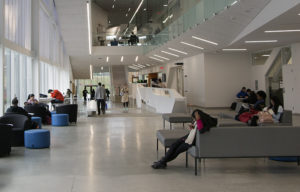New technology helps Langara College reach environmental goal
Building T design was a collaboration between two architect firms to make it more environmental and more social
Reported by Becca Clarkson
Langara’s Science and Technology Building earned 67 LEED points, missing the 80 points required for the highest level of certification, it was revealed last month.
Leadership in Energy and Environmental Design is a rating system challenging buildings to be as environmentally friendly as possible. It was announced last year that Langara received a gold certification, though its score was not divulged. To earn platinum, the highest level, a building has to have its own energy source.
New technology on Building T roof
The first ever Thermenex-In-A-Box is installed on the roof of Building T, according to Jeff Weston, Thermenex engineer. Thermenex is patented piping that combines heating and cooling systems so energy can be recaptured from its exhaust.
“We went to Langara and said ‘I’ve got this idea, I’m pretty sure it will work and it’s going to be revolutionary if it does’,” Weston said. “They teach their students to be entrepreneurs and risk takers, so Langara practices what they teach.”
Stephen Teeple, architect at Teeple Architects, one of the firms that designed Building T, said science buildings can be large energy consumers. Reports from Teeple Architects show that Thermenex technology saves the building 46 per cent in costs, and 63 per cent in energy consumption. Thermenex was first used by Langara in Building C and the Students’ Union Building in 2008.
“To make them work efficiently for the college is a massive savings in annual energy costs,” Teeple said.
Building designed to bring students together
As well as environmental sustainability, the team behind the Building T also designed with social sustainability, according to Kori Chan, architect at Proscenium Architects & Interior.

“The vortex lounges connect at half levels, so we’re hoping that as a student from the fifth floor comes to work in the lounge, someone from the fourth floor also comes up. Then you’ll have students from every department working and socializing together,” Chan said.
The infrastructure of the Building T is set up for solar panels to be installed in the future, according to Chan. The physics department also hopes to install monitoring instruments and incorporate that data into their course work.


Comments are closed.